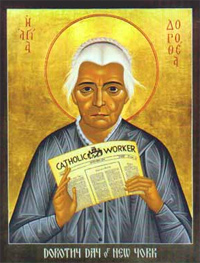 Christine Haider, 25, is preparing for her confirmation to the Roman Catholic Church. When asked about her confirmation name, she smiles broadly and says, "Dorothy." Seventy-five years since the founding of the Catholic Worker Movement, Dorothy Day and Peter Maurin continue to call a new generation of the faithful to a radical gospel of nonviolent resistance to evil and hospitality to the poor.
Christine Haider, 25, is preparing for her confirmation to the Roman Catholic Church. When asked about her confirmation name, she smiles broadly and says, "Dorothy." Seventy-five years since the founding of the Catholic Worker Movement, Dorothy Day and Peter Maurin continue to call a new generation of the faithful to a radical gospel of nonviolent resistance to evil and hospitality to the poor.
Started in New York City with a one-penny paper called The Catholic Worker, and eventually two houses of hospitality for homeless women and men, the Catholic Worker Movement has bloomed to at least one house of hospitality and war resistance in most states, along with houses in Canada, Mexico, England, Sweden, Germany, and New Zealand. Working both against the institutional evil of the state -- named once by Martin Luther King Jr. as the triple evils of racism, militarism, and materialism -- and for the victims of the state, the houses spring up in an organic meeting between the unique charism of the Catholic Workers involved and the needs of the community. There are Catholic Worker farms as well, according to Maurin's determination to give the poor an opportunity to work and live in dignity and find their sustenance in community and in communion with the land. There are no requirements for calling a project a Catholic Worker, no board or standards committee, and no fees. The Catholic Worker is not a franchise but always a labor of faith and love, a home built without walls.
Somehow in making room for the marginal in society, those at times marginalized in the church also found a home. When Haider, who struggled with a call to priesthood as a teenager, is asked what Dorothy's example is to women today, she says, "The way I identify myself as a woman and the way Dorothy identified herself as a woman is very different, but, nonetheless, for me as a woman in a very patriarchal religion Dorothy is a role model of both a strong female character in the church and a way to live out the Catholic faith outside of the institution in a way that is freeing to women but also a whole host of other people." And so in its 75 years, those who found no place to minister within the church as it stood -- women, married people, persons of different races and sexualities, and those who longed to build the simple communal apostolic church recorded in the Acts of the apostles -- have often been able to contribute their gifts to the Catholic Worker. In fact, there are even Catholic Workers who are not Roman Catholic.
Perhaps the requirement to being a Catholic Worker begins with a call to prophetic presence with the poor on the breadlines and those under the hail of fire brought down by military power. In the heart of this call is God's dangerous command to love one another, a call made dangerous by a world with casual and rampant individual and institutional violence against both neighbor and enemy. Dorothy reflected on the lack of this love present in the world when she said, "We have not yet loved our neighbor with the kind of love that is a precept to the extent of laying down our life for him. And our life very often means our money ... it means our daily bread, our daily living, our rent, our clothes ...." In such a world, loving one anther can have some uncomfortable consequences, both in loss of privilege and in loss of freedom. Dorothy said herself that, "Love is indeed a harsh and dreadful thing to ask of us, of each of us, but it is the only answer."
Eda Uca-Dorn is a member of the Dorothy Day Catholic Worker House in
Got something to say about what you're reading? We value your feedback!